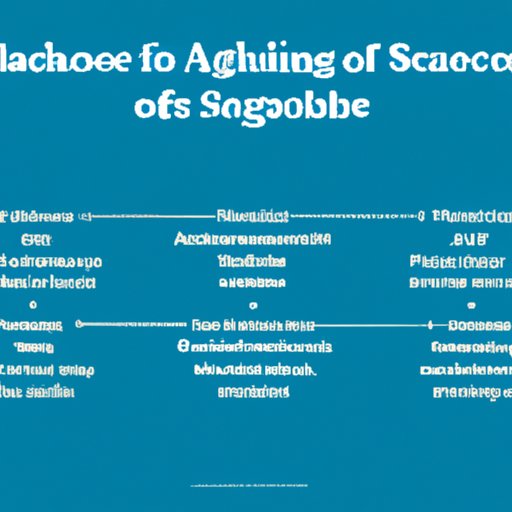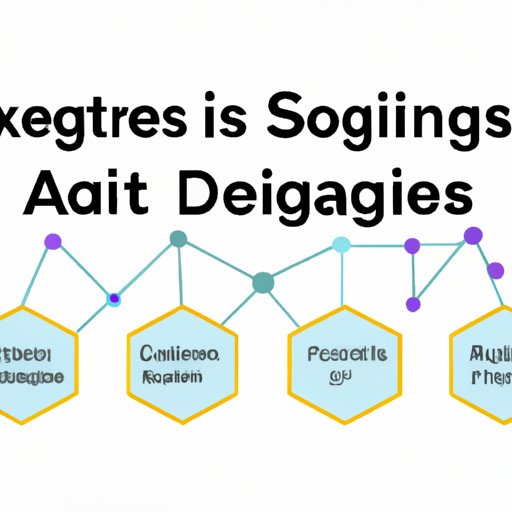Introduction
Data science has become increasingly important in today’s world, with organizations relying on it to make decisions and gain insights. Algorithms are a critical component of data science, as they allow computers to process data and learn from it. An algorithm is a set of instructions that can be used to solve a problem or accomplish a task. In data science, algorithms are used to analyze large amounts of data and uncover patterns and correlations.
The goals of this article are to provide an overview of algorithms and their importance in data science, explore the different types of algorithms used in data science, discuss how to use algorithms for data analysis and provide a comprehensive guide to the most commonly used algorithms in data science.
Exploring the Different Types of Algorithms Used in Data Science
There are three main types of algorithms used in data science: supervised learning, unsupervised learning and reinforcement learning. Supervised learning algorithms are used when there is a target variable that needs to be predicted. They use labeled data to train the model and make predictions. Unsupervised learning algorithms are used to identify patterns and clusters in data without labels. Reinforcement learning algorithms are used to maximize rewards by taking action based on the environment.
How to Use Algorithms for Data Analysis
When using algorithms for data analysis, the first step is to understand the problem. This involves assessing the data available, identifying the objectives of the analysis and determining which variables to analyze. The next step is to select the appropriate algorithm. This requires considering the type of problem and the data available. After selecting the algorithm, the data must be pre-processed to ensure accuracy. This involves cleaning the data, normalizing values and encoding categorical variables. Once the data is pre-processed, the algorithm can be trained using the training set. The trained algorithm can then be used to make predictions on the test set.

A Comprehensive Guide to Algorithms in Data Science
Linear regression is one of the most commonly used algorithms in data science. It is used to predict continuous values such as prices or weights. Logistic regression is used to classify data into two classes. Decision trees are used to create models that can be used to make predictions. Support vector machines are used to find the optimal hyperplane between two classes. K-nearest neighbor is used to classify data points based on their similarity to other points. Naive Bayes is a probabilistic classifier that is used to classify data based on probability. Random forests are used to create ensembles of decision trees. Gradient boosting is used to create ensembles of weak learners.

Top 5 Algorithms for Data Science
The top five algorithms for data science are linear regression, logistic regression, decision trees, support vector machines and k-nearest neighbor. These algorithms are used for a variety of tasks and are essential for any data scientist. They are also easy to implement and can be used for a wide range of tasks.

An Overview of the Most Commonly Used Algorithms in Data Science
Neural networks are used to build models that can learn from data. Recurrent neural networks are used to process sequences of data. Convolutional neural networks are used to process images. Long short-term memory networks are used to process sequences of data with long-term dependencies. Autoencoders are used to generate new data from existing data.
Advanced Algorithms for Data Science: What You Need to Know
Generative adversarial networks are used to generate new data from existing data. Deep reinforcement learning is used to train agents to take actions in an environment. Transfer learning is used to apply knowledge from one domain to another.

An Introduction to Applying Algorithms in Data Science
Once an algorithm is selected and trained, it must be evaluated. This involves measuring performance metrics such as accuracy, precision and recall. The algorithm can then be optimized by tuning the hyperparameters. Finally, automated model selection and tuning can be used to select the best model and optimize it.
Conclusion
Algorithms are an essential part of data science and are used to analyze large amounts of data and uncover patterns and correlations. There are three main types of algorithms used in data science: supervised learning, unsupervised learning and reinforcement learning. The most commonly used algorithms in data science are linear regression, logistic regression, decision trees, support vector machines and k-nearest neighbor. Advanced algorithms such as generative adversarial networks, deep reinforcement learning and transfer learning can also be used. To apply algorithms in data science, it is important to evaluate performance metrics, optimize algorithms and automate model selection and tuning.
(Note: Is this article not meeting your expectations? Do you have knowledge or insights to share? Unlock new opportunities and expand your reach by joining our authors team. Click Registration to join us and share your expertise with our readers.)
